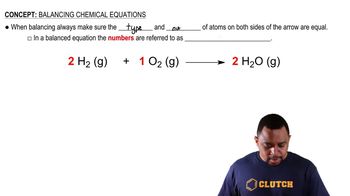Indicate whether the following balanced equations involve oxidation–reduction. If they do, identify the elements that undergo changes in oxidation number. (b) NaI(aq) + 3 HOCl(aq) → NaIO3(aq) + 3 HCl(aq)
Hydrazine 1N2H42 and dinitrogen tetroxide 1N2O42 form a self-igniting mixture that has been used as a rocket propellant. The reaction products are N2 and H2O. (c) Which substance serves as the reducing agent and which as the oxidizing agent?

Verified Solution
Key Concepts
Oxidation and Reduction

Oxidizing and Reducing Agents

Balancing Chemical Reactions

Indicate whether the following balanced equations involve oxidation–reduction. If they do, identify the elements that undergo changes in oxidation number. (a) 2 AgNO3(aq) + CoCl2(aq) → 2 AgCl(s) + Co(NO3)2(aq)
At 900 °C, titanium tetrachloride vapor reacts with molten magnesium metal to form solid titanium metal and molten magnesium chloride. (a) Write a balanced equation for this reaction.
Complete and balance the following half-reactions. In each case, indicate whether the half-reaction is an oxidation or a reduction. (b) TiO21s2 ¡ Ti2+1aq2 (acidic solution)
Complete and balance the following half-reactions. In each case, indicate whether the half-reaction is an oxidation or a reduction. (f) SO32-1aq2 ¡ SO42-1aq2 (basic solution)
Complete and balance the following half-reactions. In each case indicate whether the half-reaction is an oxidation or a reduction. (b) H2SO31aq2 ¡ SO42-1aq2 (acidic solution)
